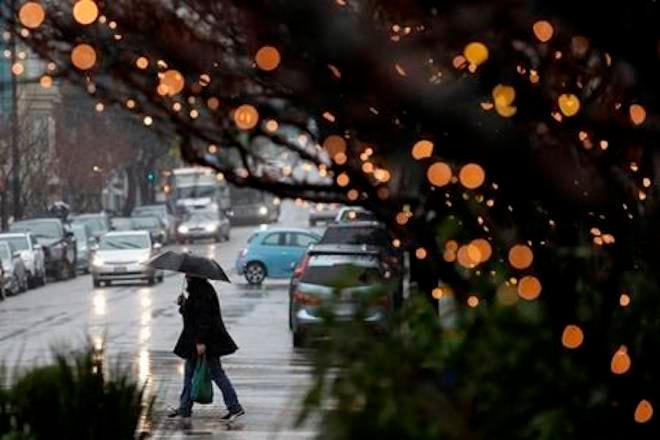More rain, snow and wind hit the West on Wednesday, flooding roads, toppling trees and cutting power while raising threats of debris flows from wildfire scars.
The tempest, aimed at California and southern Oregon and barrelling toward Nevada, was feeding on a deep plume of moisture stretching across the Pacific Ocean to near Hawaii, the National Weather Service said.
The storm followed more than a week of severe weather in the Pacific Northwest and was the latest in a series that has all but eliminated drought-level dryness in California this winter.
It's doing the thing! (video) #snow #Vegas #VegasWeather #NVwx pic.twitter.com/EgcKVDq6qq
— Caleb Steele (@caleb_steele) February 11, 2019
Winter storm warnings were posted in the snow-laden Sierra Nevada, where the forecast says up to 7 feet (2.1 metres) of new snow could be dumped at elevations above 9,000 feet (2,743 metres).
READ MORE: Snow, ice and high winds for Ontario, Quebec as storm sweeps in
The National Weather Service recorded winds gusting to 132 mph (213 kph) late Tuesday and early Wednesday atop the Mount Rose ski resort southwest of Reno, Nevada.
A backcountry avalanche warning was issued throughout the Sierra.
“We are still trying to dig out of the last system and we have another big storm here,” said Kevin “Coop” Cooper, spokesman for Kirkwood Mountain Resort south of Lake Tahoe.
Snow heavily impacted stretches of vital Interstate 5 in far northern California, causing closures and forcing tire chain requirements.
A local state of emergency was declared in Shasta County due to “significant” storm damage, a Sheriff’s Office statement said. Redding, the county seat, turned its library into a warming centre.
Power outages also hit thousands of utility customers in the region.
In the fire-scarred Gold Rush town of Magalia, resident Doug Sheridan woke up to find electricity out across his neighbourhood, apparently the result of a fallen tree limb that downed a power line.
“It finally came back on about 9:15,” he said by phone as heavy rain pounded his house, melting snow that fell the night before and causing it to break off in large chunks and splatter on the ground.
Widespread roadway flooding occurred north of San Francisco Bay. To the east, a swath of California’s Central Valley was under a flood warning.
At one point, flight arrivals at San Francisco International Airport were experiencing delays of several hours, the Federal Aviation Administration said.
In the Fresno County city of Sanger, police posted social media photos of wind damage to the roof of a school along with snapped trees.
Even before the storm spread into Southern California, voluntary evacuation warnings were in effect for some areas near a burn scar on the Riverside County side of the Santa Ana Mountains.
In Santa Barbara County , hard-hit by a devastating debris flow in January 2018, officials predicted rainfall rates were below thresholds for new flows, but residents were still advised to stay alert.
In Washington, about 12,000 Puget Sound Energy customers remained without power Wednesday and Interstate 90 was closed for a second day across Snoqualmie Pass in the Cascade Mountains. The town of North Bend declared a state of emergency due to several feet of snow.
In Oregon transportation officials closed about 20 miles (32 kilometres) of the westbound lanes of Interstate 84 in the Columbia River Gorge east of Portland due to icy conditions that caused numerous wrecks and stranded some drivers for hours. By early Wednesday afternoon some vehicles were moving but authorities were still restricting new traffic.
READ MORE: ‘Laws of physics apply to everybody’: RCMP warn drivers as winter hits B.C.
“This is a very, very serious situation out there right now,” Don Hamilton, an Oregon Department of Transportation spokesman, told The Oregonian/OregonLive.
Authorities brought stranded travellers water and food and tried to get gas to vehicles that needed it.
The West’s winter storms have greatly aided California’s water supply.
The most recent Sierra snowpack survey taken on Jan. 31 was 100 per cent of normal to date and more snow has fallen since.
In the Eastern Sierra, the Mammoth Mountain resort reported the latest storm had already added another 8 inches (20.3 centimetres) to its summit season total, which is nearing 38 feet (11.5 metres).
Mammoth said it planned to keep its slopes open to skiing and boarding through the Fourth of July, at least.
John Antczak, The Associated Press
